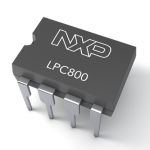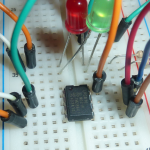 In the past, ARM microcontrollers have been available only in packages which are rather unfriendly for hobbyist use. However, NXP is now producing two Cortex-M0 microcontrollers in DIP packages, which are very handy for breadboard use and trough-hole soldering. The chips are LPC1114 in DIP28 package and LPC810 in DIP8 package. LPC1114FN28/102 has 32 kB flash and 8 kB ram, which is actually quite nice and allows running even a small RTOS. LPC810M021FN8 has only 4 kB flash and 1 kB ram, which is not much but still suitable for small bare metal applications.
In the past, ARM microcontrollers have been available only in packages which are rather unfriendly for hobbyist use. However, NXP is now producing two Cortex-M0 microcontrollers in DIP packages, which are very handy for breadboard use and trough-hole soldering. The chips are LPC1114 in DIP28 package and LPC810 in DIP8 package. LPC1114FN28/102 has 32 kB flash and 8 kB ram, which is actually quite nice and allows running even a small RTOS. LPC810M021FN8 has only 4 kB flash and 1 kB ram, which is not much but still suitable for small bare metal applications.
LPC810 costs only about 1€ and LPC1114 about 2€ at mouser.
Of course I had to adapt my blink-test pico]OS project for these chips. I started with LPC1114 as it has more memory, so I wouldn’t have to spend a lot of time fine-tuning memory amounts. I just put the chip into breadboard with three leds. A FTDI rs232-converter allows access to usart and provides also 3.3V for the cpu. These Cortex-M0 chips support only SWD debugging (no JTAG), so I ended up in uploading the compiled program to chip with FlashMagic (it is a free tool that loads hex-formatted images to LPC chips vial serial “ISP” boot loader). After some trial and error I got a working system (SWD debugging dongle would have been nice): 3 leds being blinked by 3 RTOS threads.
 LPC810 was more difficult. I had to trim everything unnecessary away from the pico]OS configuration. That means no serial console, minimal stack sizes and only 2 leds & threads. It was also necessary to compile program with gcc optimisation enabled (so no debugging with this chip), otherwise the code size is too big. I ended also leaving some cmsis initialisation out (one might consider LPCOpen a little bloated for this little buddy), running the cpu with default speed.
LPC810 was more difficult. I had to trim everything unnecessary away from the pico]OS configuration. That means no serial console, minimal stack sizes and only 2 leds & threads. It was also necessary to compile program with gcc optimisation enabled (so no debugging with this chip), otherwise the code size is too big. I ended also leaving some cmsis initialisation out (one might consider LPCOpen a little bloated for this little buddy), running the cpu with default speed.
But it works! Only 4 kB of flash and 1 kB of ram is enough for real time operating system and 2 application threads ! However, I must admit that there is not much space left for real application, but anyway this was an interesting experiment.
Source code is available at GitHub.




